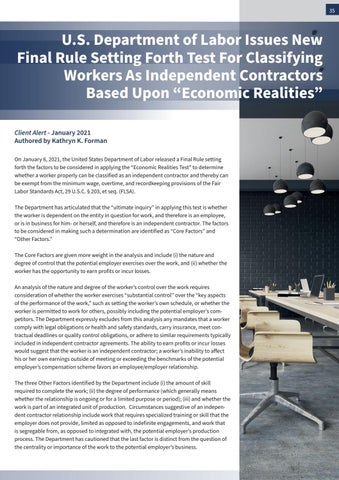35
U.S. Department of Labor Issues New Final Rule Setting Forth Test For Classifying Workers As Independent Contractors Based Upon “Economic Realities” Client Alert - January 2021 Authored by Kathryn K. Forman On January 6, 2021, the United States Department of Labor released a Final Rule setting forth the factors to be considered in applying the “Economic Realities Test” to determine whether a worker properly can be classified as an independent contractor and thereby can be exempt from the minimum wage, overtime, and recordkeeping provisions of the Fair Labor Standards Act, 29 U.S.C. § 203, et seq. (FLSA). The Department has articulated that the “ultimate inquiry” in applying this test is whether the worker is dependent on the entity in question for work, and therefore is an employee, or is in business for him- or herself, and therefore is an independent contractor. The factors to be considered in making such a determination are identified as “Core Factors” and “Other Factors.” The Core Factors are given more weight in the analysis and include (i) the nature and degree of control that the potential employer exercises over the work, and (ii) whether the worker has the opportunity to earn profits or incur losses. An analysis of the nature and degree of the worker’s control over the work requires consideration of whether the worker exercises “substantial control” over the “key aspects of the performance of the work,” such as setting the worker’s own schedule, or whether the worker is permitted to work for others, possibly including the potential employer’s competitors. The Department expressly excludes from this analysis any mandates that a worker comply with legal obligations or health and safety standards, carry insurance, meet contractual deadlines or quality control obligations, or adhere to similar requirements typically included in independent contractor agreements. The ability to earn profits or incur losses would suggest that the worker is an independent contractor; a worker’s inability to affect his or her own earnings outside of meeting or exceeding the benchmarks of the potential employer’s compensation scheme favors an employee/employer relationship. The three Other Factors identified by the Department include (i) the amount of skill required to complete the work; (ii) the degree of performance (which generally means whether the relationship is ongoing or for a limited purpose or period); (iii) and whether the work is part of an integrated unit of production. Circumstances suggestive of an independent contractor relationship include work that requires specialized training or skill that the employer does not provide, limited as opposed to indefinite engagements, and work that is segregable from, as opposed to integrated with, the potential employer’s production process. The Department has cautioned that the last factor is distinct from the question of the centrality or importance of the work to the potential employer’s business.



















